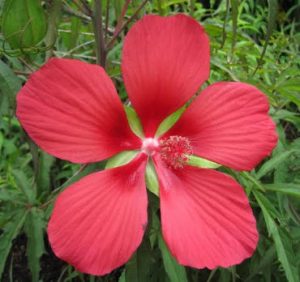
Texas Star Hibiscus (Hibiscus coccineus), also known as Scarlet Rose Mallow or Swamp Hibiscus, is a striking perennial plant admired for its large, star-shaped red flowers. These blooms, which can reach up to 6 inches in diameter, appear from midsummer to early fall and are a magnet for pollinators, including bees, butterflies, and hummingbirds. The plant’s deeply lobed, palmate leaves add a tropical flair to gardens, making it a popular choice for ornamental landscaping.
History
Native to the southeastern United States, the Texas Star Hibiscus is well-suited for wetland areas, such as swamps and marshes. Its natural habitat spans states like Florida, Georgia, and Alabama. Over time, it has become a favorite among gardeners for its dramatic appearance and adaptability to cultivated landscapes.
Growing and Maintenance Tips
- Light: Prefers full sun but can tolerate partial shade. Full sun encourages more prolific blooming.
- Soil: Thrives in moist, well-draining soil and adapts to sandy, loamy, or silty conditions. Slightly acidic to neutral soil (pH 6.0–7.0) is ideal.
- Watering: Requires consistently moist soil, especially during the growing season. It can tolerate “wet feet,” making it suitable for rain gardens or areas near water features.
- Temperature: Hardy in USDA zones 5–9. It can withstand mild frost and will often regrow from the roots in spring if dieback occurs during winter.
- Fertilizer: Apply a balanced fertilizer monthly during the growing season to support its vigorous growth and abundant blooms.
- Pruning: Prune lightly to control height and shape. Since flowers appear on new growth, avoid heavy pruning during the growing season.
- Propagation: It can be propagated through seeds or cuttings. After flowering, collect seeds from the spiky seed pods.
The Texas Star Hibiscus is a low-maintenance plant that adds bold color and texture to gardens. Its ability to thrive in wet conditions makes it an excellent choice for bog gardens or areas with poor drainage.
